This article is about Aircraft Parts and its components. Aircraft are complex machines composed of numerous components working together to enable flight. These components can be categorized into several main groups, each serving a specific function in the operation of the aircraft.
Aircraft Parts
Before explaining into the intricacies of atmospheric flight, it’s essential to familiarize ourselves with the fundamental parts of an aircraft. In particular, we’ll focus on commercial airplanes operating in high subsonic regimes, as they are among the most common aircraft in use today.
At the heart of every commercial aircraft is the fuselage, which serves as the central body housing the flight crew, passengers, luggage, and cargo. It provides the structural framework and interior space for occupants and payload.
The primary lifting component of the aircraft is the wing. Positioned along the fuselage, the wing generates the lift force necessary for flight through the aerodynamic principles of airfoil design. The shape and configuration of the wing vary based on the aircraft’s design requirements and performance characteristics.
The fuselage is a critical component of an aircraft, serving as its main body or central structure. It provides housing for the flight crew, passengers, cargo, and essential equipment, as well as serving as the primary load-bearing structure of the aircraft. The shape, size, and design of the fuselage vary depending on the type and purpose of the aircraft, but its fundamental function remains consistent across different aircraft configurations.
1. Fuselage
The fuselage is a critical component of an aircraft, serving as its main body or central structure. It provides housing for the flight crew, passengers, cargo, and essential equipment, as well as serving as the primary load-bearing structure of the aircraft. The shape, size, and design of the fuselage vary depending on the type and purpose of the aircraft, but its fundamental function remains consistent across different aircraft configurations.
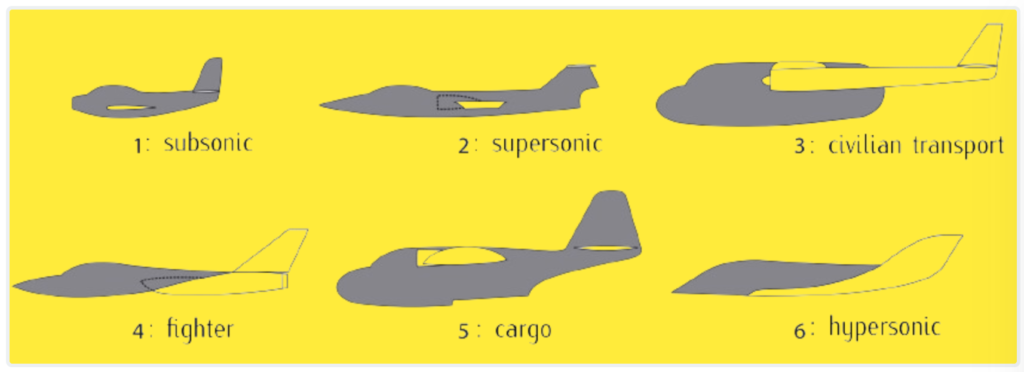
The fuselage is like the main body of the airplane where people and cargo are carried. It’s like the central space of the aircraft where passengers sit, luggage is stored, and the crew operates the plane. The fuselage also holds important equipment for flying, like the cockpit where the pilots sit and control everything. It’s basically the big, central part of the airplane that everything else is connected to.
When engineers design a fuselage, they have to think about two main things: making it streamlined so it moves smoothly through the air, and making sure it has enough room inside for passengers and cargo. Most of the inside space is dedicated to the passenger cabin, where seats and aisles are arranged according to safety rules and the airline’s preferences. Cargo is usually stored below the passenger cabin in big commercial planes.
There are different types of fuselage designs depending on the airplane’s purpose and the airline’s preferences. Some may have wider seats and more legroom for comfort, while others might have smaller seats to fit more people. It all depends on the type of airplane and how the airline wants to use it.
2. Wing
The wing of an airplane is like its big, flat arms that stick out from the fuselage (the main body). These wings are super important because they’re what actually lift the airplane up into the sky. When air flows over and under the wing, it creates something called lift, which helps the plane stay up in the air.
A wing is a critical component of an aircraft, designed with an aerodynamic shape to produce lift and minimize drag. The efficiency of a wing is often expressed as its lift-to-drag ratio, indicating how effectively it generates lift compared to the drag it creates. A higher lift-to-drag ratio means the wing requires less thrust to maintain flight.
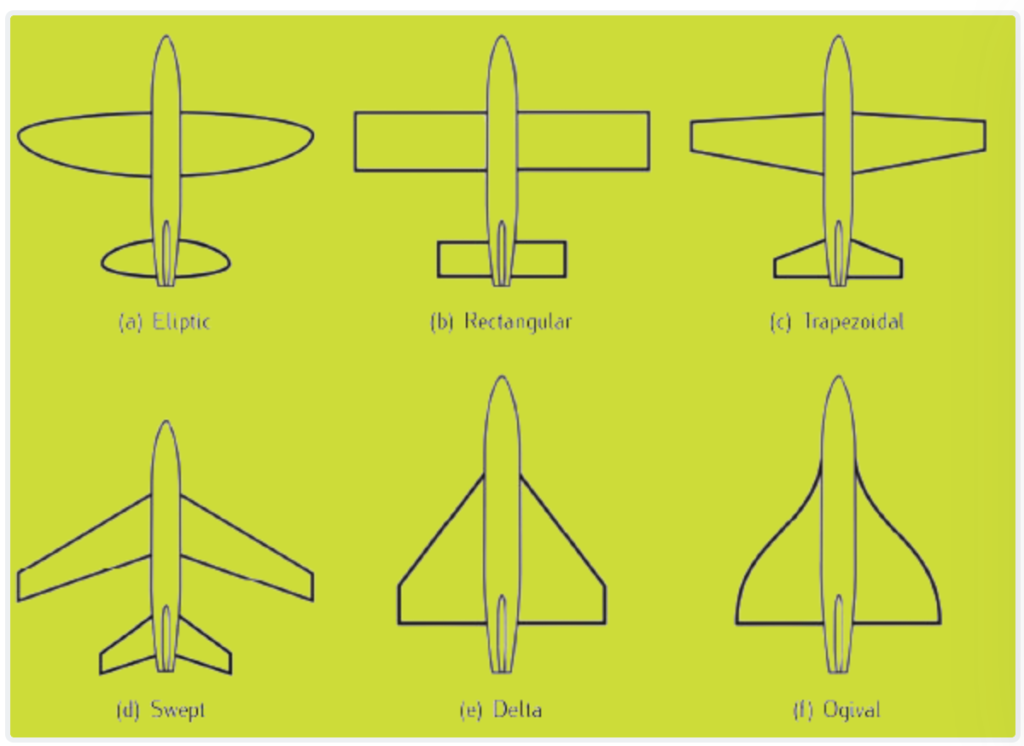
Wings can be classified based on their planform, which refers to the overall shape when viewed from above. The elliptic planform offers the best aerodynamic efficiency but is complex to manufacture. Rectangular wings are simpler to build but are less efficient aerodynamically. An intermediate option is the tapered wing, which narrows gradually from root to tip. As airspeed approaches the speed of sound, swept wings are designed to mitigate the increase in aerodynamic drag associated with transonic speeds. Delta wings, typically seen in supersonic aircraft, are another design option, with an evolved version called the ogival planform.
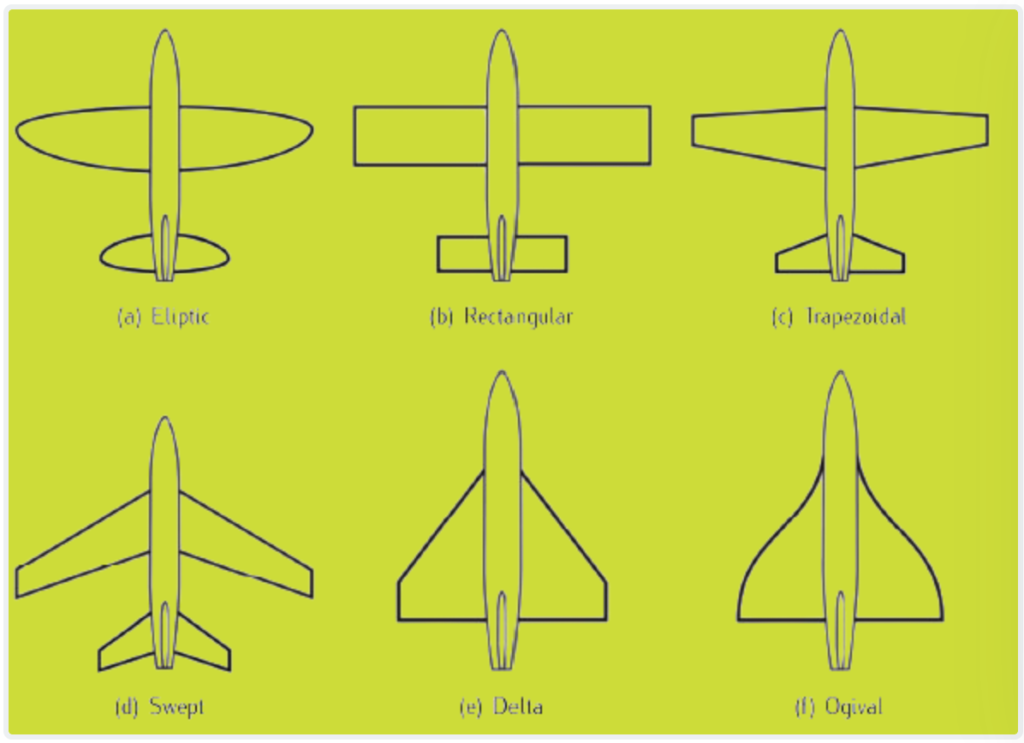
In addition to planform, wings can be classified based on their vertical position relative to the fuselage. High wings are common in cargo aircraft, allowing for easier loading and unloading but complicating landing gear placement. Low wings, typical in commercial aviation, provide space for the passenger cabin and facilitate landing gear placement. Medium wings, less common in commercial aircraft, are often used in combat aircraft with weapons mounted beneath them.
Aircraft wings often incorporate various devices to enhance their performance and control. Flaps and slats can be extended or retracted to adjust the wing’s shape and surface area, altering its aerodynamic characteristics during flight. Ailerons, located on the trailing edge of the wings, are used to roll the aircraft around its longitudinal axis for banking maneuvers. Spoilers are deployed to reduce lift on one side of the wing, aiding in braking during landing or assisting with descent. When deployed symmetrically, spoilers can decrease overall lift, facilitating rapid descent or braking after touchdown.
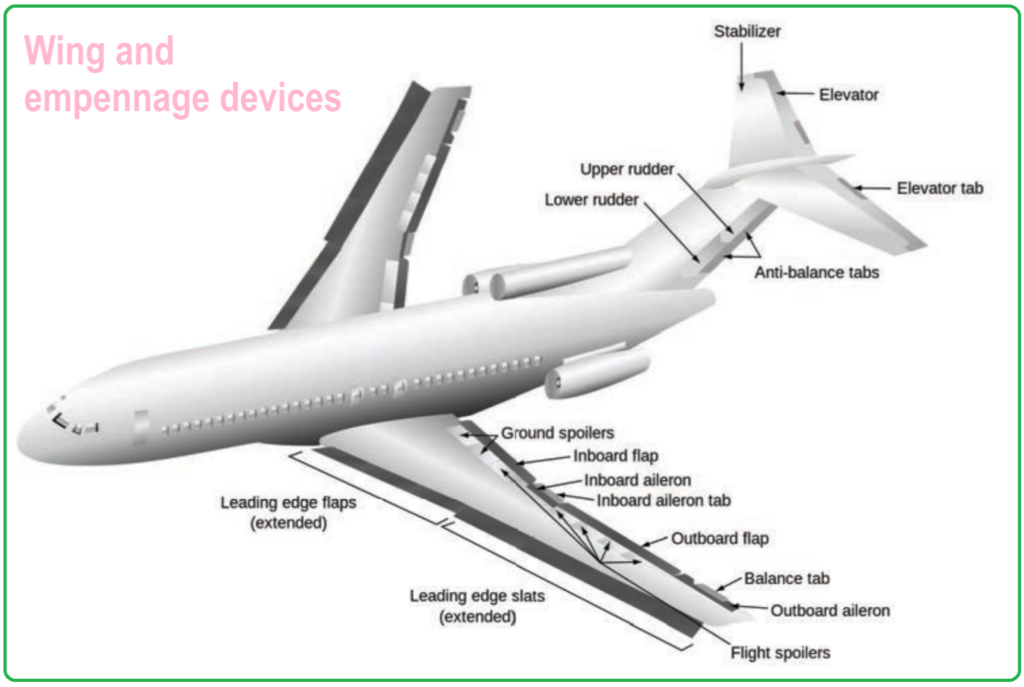
3. Empennage
The empennage, also known as the tail assembly or tail section, is a critical component of an aircraft located at the rear end. It typically consists of the horizontal stabilizer, vertical stabilizer, and associated control surfaces such as elevators, rudders, and sometimes a trim tab.
The empennage, also referred to as the tail or tail assembly, plays a crucial role in providing stability to an aircraft during flight. It consists of vertical and horizontal stabilizing surfaces, which help stabilize the aircraft’s pitch and yaw dynamics, as well as housing various control surfaces that allow the pilot to maneuver the aircraft effectively.
Empennage Types
There are several configurations for the empennage, each with its own advantages and considerations:
- Conventional Tail: Also known as a low tail configuration, this setup features horizontal stabilizers mounted on the fuselage, typically below the vertical stabilizer. It is commonly used in aircraft with engines located under the wings. This configuration is structurally compact and aerodynamically efficient.
- Cruciform Tail: In this configuration, the horizontal stabilizers are positioned midway up the vertical stabilizer, giving the appearance of a cross when viewed from the front. Cruciform tails are often chosen to keep the horizontal stabilizers clear of the engine wake, while avoiding some of the drawbacks associated with T-tails.
- T-Tail: The T-tail configuration places the horizontal stabilizer on top of the vertical fin, forming a “T” shape when viewed from the front. T-tails are preferred for their ability to keep the stabilizers clear of the engine wake, providing better pitch control. However, they are more prone to deep stalls and spins, requiring stronger and heavier structures.
- Twin Tail or V-Tail: These configurations are less common but still used in certain aircraft designs. Twin tails feature two separate vertical stabilizers and associated horizontal stabilizers, while V-tails combine the functions of both vertical and horizontal stabilizers into a single surface.
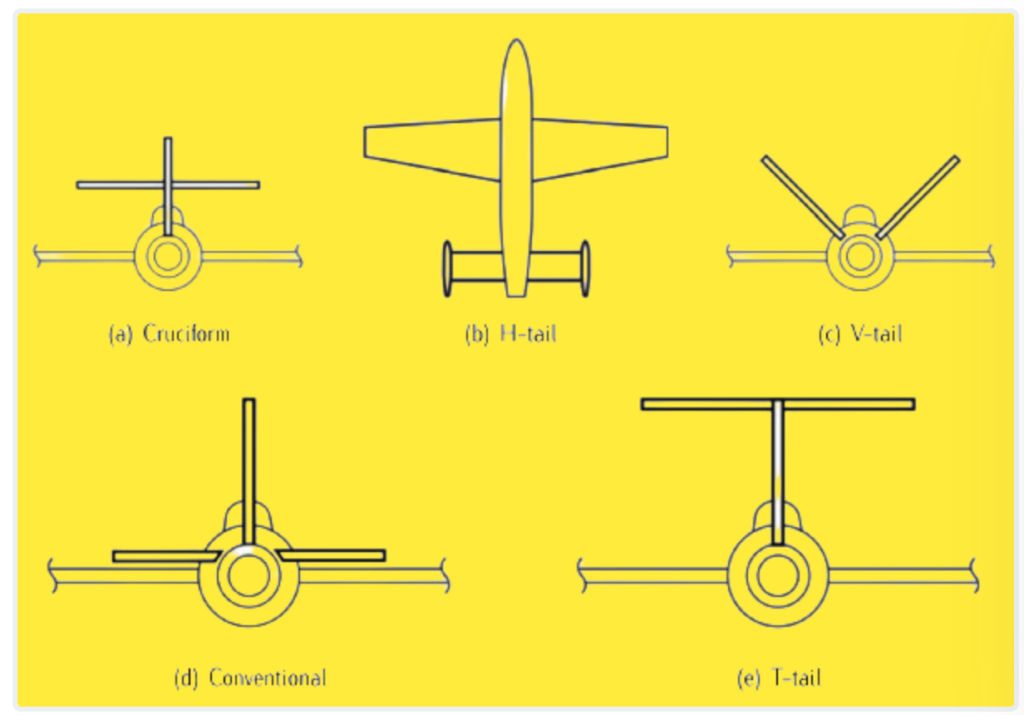
The choice of empennage configuration depends on various factors such as aircraft design requirements, aerodynamic considerations, and operational needs. Each configuration offers a balance of advantages and trade-offs, and designers must carefully evaluate these factors to determine the most suitable option for a particular aircraft parts.
4. Main control surfaces
The main control surfaces of an aircraft are important components that allow pilots to control the aircraft’s movement and attitude during flight. These control surfaces are typically movable sections of the wings and tail, which can be adjusted by the pilot to change the aircraft’s direction, altitude, and orientation in the air.

The main control surfaces of a fixed-wing aircraft play a crucial role in maneuvering the aircraft by deflecting the airflow around them. These control surfaces are strategically positioned on the wings and tail of the aircraft and include the ailerons, elevator, and rudder.
Ailerons are located on the trailing edge of each wing near the wingtips and move in opposite directions. When the pilot inputs a control movement, such as moving the stick to the left, the left aileron rises while the right aileron lowers. This action reduces lift on one wing and increases it on the other, causing the aircraft to roll in the desired direction.
The elevator is situated on the trailing edge of the horizontal stabilizer, typically at the rear of the aircraft’s tail. Like the ailerons, the elevator moves in unison, with both sides going up or down together. Pulling the stick backward raises the elevators, causing the nose of the aircraft to pitch upward, while pushing the stick forward has the opposite effect, pitching the nose downward.
The rudder is mounted on the trailing edge of the vertical stabilizer, which is part of the aircraft’s empennage. The rudder moves left or right when the pilot operates the foot pedals. Pressing the left pedal deflects the rudder to the left, yawing the aircraft to the right, and vice versa. Centering the rudder pedals returns the rudder to its neutral position, stopping the yawing motion.
These main control surfaces work in tandem to provide the pilot with precise control over the aircraft’s movements in roll, pitch, and yaw. By manipulating these control surfaces, pilots can execute various maneuvers, such as turns, climbs, descents, and level flight, ensuring safe and efficient operation of the aircraft throughout its flight.
5. Propulsion plant
The propulsion plant of an aircraft refers to the system responsible for generating the thrust required to propel the aircraft through the air. There are various types of propulsion systems used in aircraft, each with its own unique characteristics and applications. The primary goal of the propulsion plant is to convert energy from a fuel source into forward motion.

The propulsion systems used in aircraft are essential for generating the necessary thrust to overcome drag and propel the aircraft through the air. These systems can be broadly categorized into two main groups: propellers and jets.
Propellers: Propellers are a type of fan that converts rotational motion into thrust by accelerating air rearward. They are typically driven by piston engines or turboprop engines. Piston engines, once common in aircraft propulsion, are now primarily used in light aircraft due to their weight and inefficiency at high altitudes. Turboprop engines, on the other hand, use a turbine engine to drive a propeller via a reduction gear. Turboprops are known for their efficiency in low subsonic regimes, making them suitable for regional and commuter aircraft.
Jet Engines: Jet engines operate on the principle of jet propulsion, where fast-moving exhaust gases are expelled rearward to generate thrust. There are several types of jet engines, including turbojets, turbofans, rockets, ramjets, and pulse jets. Turbojets were among the earliest jet engines used in aircraft, but they are relatively inefficient for subsonic flight. Modern subsonic jet aircraft typically use high-bypass turbofan engines, which feature a large fan at the front that accelerates air around the engine core. This design provides high speeds at a reasonable fuel efficiency, making turbofans suitable for long-haul travel.
Overall, the choice between propellers and jet engines depends on factors such as aircraft size, mission requirements, operating environment, and fuel efficiency considerations. While propellers are more common in smaller aircraft and turboprops excel in low-speed flight, jet engines, particularly turbofans, dominate in commercial aviation for their ability to deliver high speeds efficiently over long distances.